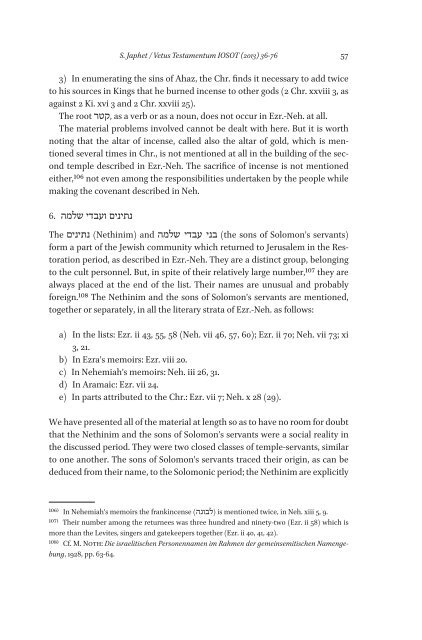Special Issue IOSOT 2013 - Books and Journals
Special Issue IOSOT 2013 - Books and Journals
Special Issue IOSOT 2013 - Books and Journals
Create successful ePaper yourself
Turn your PDF publications into a flip-book with our unique Google optimized e-Paper software.
S. Japhet / Vetus Testamentum <strong>IOSOT</strong> (<strong>2013</strong>) 36-76 57<br />
3) In enumerating the sins of Ahaz, the Chr. finds it necessary to add twice<br />
to his sources in Kings that he burned incense to other gods (2 Chr. xxviii 3, as<br />
against 2 Ki. xvi 3 <strong>and</strong> 2 Chr. xxviii 25).<br />
The root ,קטר as a verb or as a noun, does not occur in Ezr.-Neh. at all.<br />
The material problems involved cannot be dealt with here. But it is worth<br />
noting that the altar of incense, called also the altar of gold, which is mentioned<br />
several times in Chr., is not mentioned at all in the building of the second<br />
temple described in Ezr.-Neh. The sacrifice of incense is not mentioned<br />
either,106 not even among the responsibilities undertaken by the people while<br />
making the covenant described in Neh.<br />
נתינים ועבדי שלמה .6<br />
The נתינים (Nethinim) <strong>and</strong> בני עבדי שלמה (the sons of Solomon’s servants)<br />
form a part of the Jewish community which returned to Jerusalem in the Restoration<br />
period, as described in Ezr.-Neh. They are a distinct group, belonging<br />
to the cult personnel. But, in spite of their relatively large number,107 they are<br />
always placed at the end of the list. Their names are unusual <strong>and</strong> probably<br />
foreign.108 The Nethinim <strong>and</strong> the sons of Solomon’s servants are mentioned,<br />
together or separately, in all the literary strata of Ezr.-Neh. as follows:<br />
a) In the lists: Ezr. ii 43, 55, 58 (Neh. vii 46, 57, 60); Ezr. ii 70; Neh. vii 73; xi<br />
3, 21.<br />
b) In Ezra’s memoirs: Ezr. viii 20.<br />
c) In Nehemiah’s memoirs: Neh. iii 26, 31.<br />
d) In Aramaic: Ezr. vii 24.<br />
e) In parts attributed to the Chr.: Ezr. vii 7; Neh. x 28 (29).<br />
We have presented all of the material at length so as to have no room for doubt<br />
that the Nethinim <strong>and</strong> the sons of Solomon’s servants were a social reality in<br />
the discussed period. They were two closed classes of temple-servants, similar<br />
to one another. The sons of Solomon’s servants traced their origin, as can be<br />
deduced from their name, to the Solomonic period; the Nethinim are explicitly<br />
106) In Nehemiah’s memoirs the frankincense (לבונה) is mentioned twice, in Neh. xiii 5, 9.<br />
107) Their number among the returnees was three hundred <strong>and</strong> ninety-two (Ezr. ii 58) which is<br />
more than the Levites, singers <strong>and</strong> gatekeepers together (Ezr. ii 40, 41, 42).<br />
108) Cf. M. Noth: Die israelitischen Personennamen im Rahmen der gemeinsemitischen Namengebung,<br />
1928, pp. 63-64.








![Am HaSefer [Volk des Buches] - Books and Journals](https://img.yumpu.com/20648352/1/174x260/am-hasefer-volk-des-buches-books-and-journals.jpg?quality=85)







